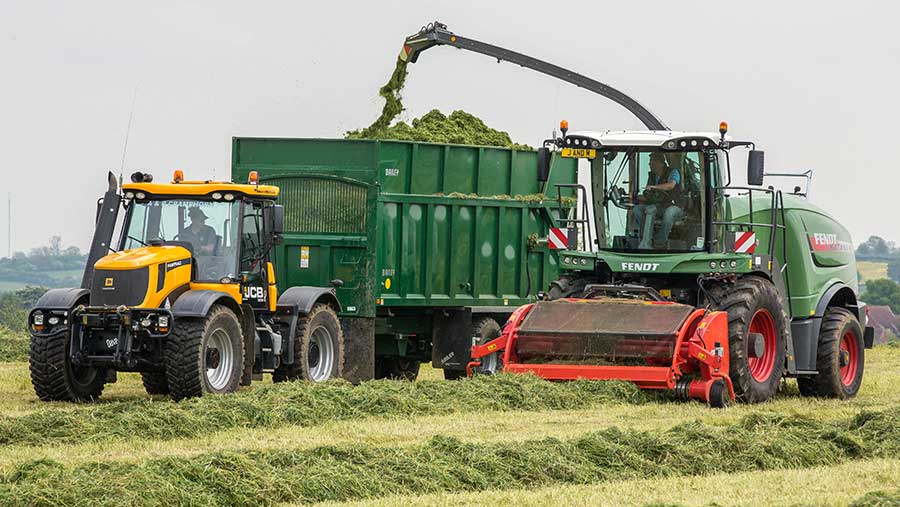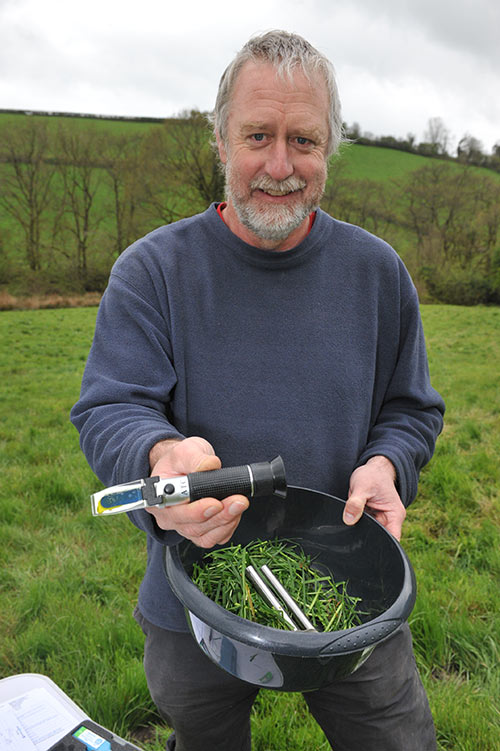How to ‘home-test’ grass to know when to cut for silage
 © Tim Scrivener
© Tim Scrivener When there is late application of fertiliser and slurry to crops, it is vital important to test grass before cutting for silage.
Excess nitrogen is a risk in these fields because it will depress grass sugars and increase the protein level of the crop, causing poor fermentation in the clamp.
High ammonia in silage comes from protein breakdown and by clostridial organisms, explains Dr David Davies of Silage Solutions.
“The protein breakdown occurs when too little acid is produced in the fermentation because of a lack of sugar, or too high residual nitrate from fertiliser or slurry buffering the pH decline,’’ he says.
See also: First-cut silage runs high risk of slurry contamination
To avoid these issues, Dr Davies advises farmers to use a simple and relatively low-cost refractometer – the same device used to measure colostrum quality.

Dr David Davies with a refractometer and grass sample
It gives an instant and relatively accurate reading of the grass sugar content. The nitrate content can also be analysed on-farm, using a meter or testing strips.
Watch the video and read Dr Davies’ advice below on how to carry out the test and what to look for:
1. How to collect and analyse grass
- Walk across the field and take a good representative sample by taking a snip sample every few metres at the same height as the grass would be mown.
- Collect the grass in a bag.
- Consider the shape of the field – a small field will have a larger proportion of hedge grass and the grass near hedges is likely to be lower in sugar and higher in nitrate because it is shaded.
- Mix the cut grass sample and chop to approximately 1-inch lengths into a bowl, again mixing well. The mixing process is important because a representative proportion of leaf to stem is needed for the test.
- Place grass into a garlic crush and squeeze out a few drops, either directly on to the refractometer or squeeze into a small vessel and use a small syringe to put the required amount of grass juice onto the sensor.
- Hold the refractometer up to the light. You will see a green line at the bottom and a blue line at the top – where the two lines meet is the Brix score which will be shown as a percentage.
2. Sugar – what to look for and targets
A 1% Brix score represents approximately 1-2% sugar.
The refractometer will over-estimate sugar content by about 0.25% on average, so correct back accordingly.
To ensure good fermentation, the figure should be 2-3% or higher. At 2% an additive is needed but at 3% there should be enough sugar.
However, a good additive will always improve the preservation process and wilting rapidly to 30% DM will increase the sugar content on a fresh matter basis as the moisture is lost.
3. Nitrate N – what to look for and targets
A nitrate meter measures in parts per million, which is equivalent to milligrams per litre. Either can be used to give an assessment of the nitrate N content, which is crucial to silage making.
Take the grass sample using the method described above, then squeeze a sample on to the sensor of the meter.
The meter will underestimate the nitrate content by about 300 mg/kg fresh matter, so correct accordingly.
The concentration should be less than 1,500mg/kg fresh matter or 0.15% FM.
Grass will ensile correctly with up to 1,500 parts per million nitrate, provided sugars are adequate.
Wilting the crop to >28% DM helps to overcome the effects of high nitrate and low sugar.
Advantages of testing grass on-farm
Laboratory analysis gives highly accurate results, but on-farm testing can give a more reliable guide of the grass sugar and nitrate N levels, instantaneously.
The time lapse between cutting a sample and getting it to the laboratory can mean the result doesn’t accurately reflect the true content of the grass, Dr Davies explains.
“It will take a day at least to reach the lab by post and, in the meantime, the sample is changing.
“It can then be three days between sampling and getting the results back, which can affect decision-making.
“It is not that the lab analysis is incorrect, because it is not. It is more accurate than these devices if it is conducted correctly, but the time factor is important.”
Dr Davies says a refractometer and nitrate meter are useful because they can be used to analyse multiple samples from several fields and different parts of fields – with rapid results.
“A refractometer and nitrate meter enable you to get a reading instantaneously and decide what you are going to do with the crop.
“The figures are approximate, but they can be a very useful gauge for your silage making figures.’’
Sampling devices
Refractometers
There are several options available but the following two are widely used:
Cole-Parmer RSA-BR32T Refractometer. Retails at £100.80 including VAT
A digital refractometer from Harvest Agri is available at £564.88 including VAT
Nitrate testers
Laqua Twin 8-743 nitrate meter. £397.59 including VAT
Yara N tester. Purchase price £1,350 plus VAT or lease for £350/year. If you decide to buy in year 2 the purchase price is £1,150.
Other testers are available.
For a lower-cost option, nitrate sticks are manufactured by Quantofix. A box of 100 test sticks retails at £52.26 including VAT and is available from Camlab or Cole-Parmer.
